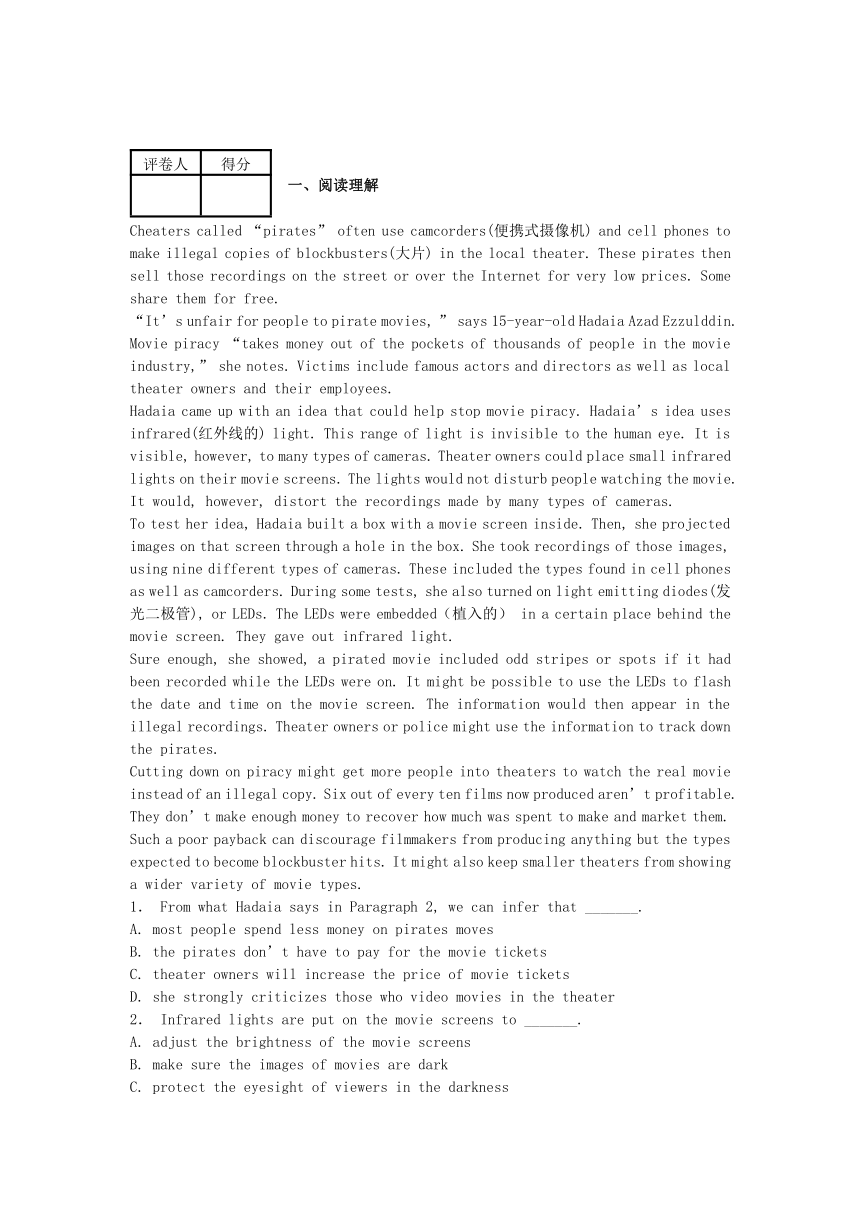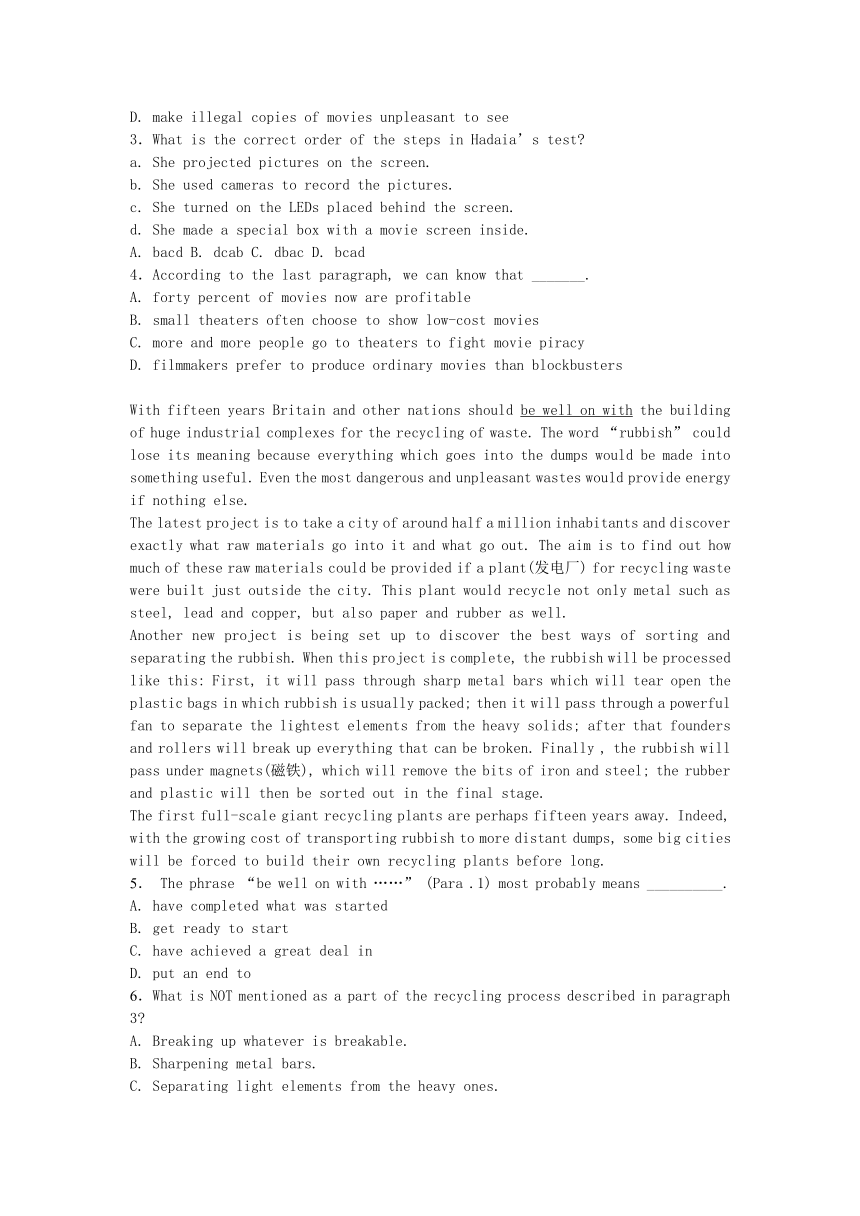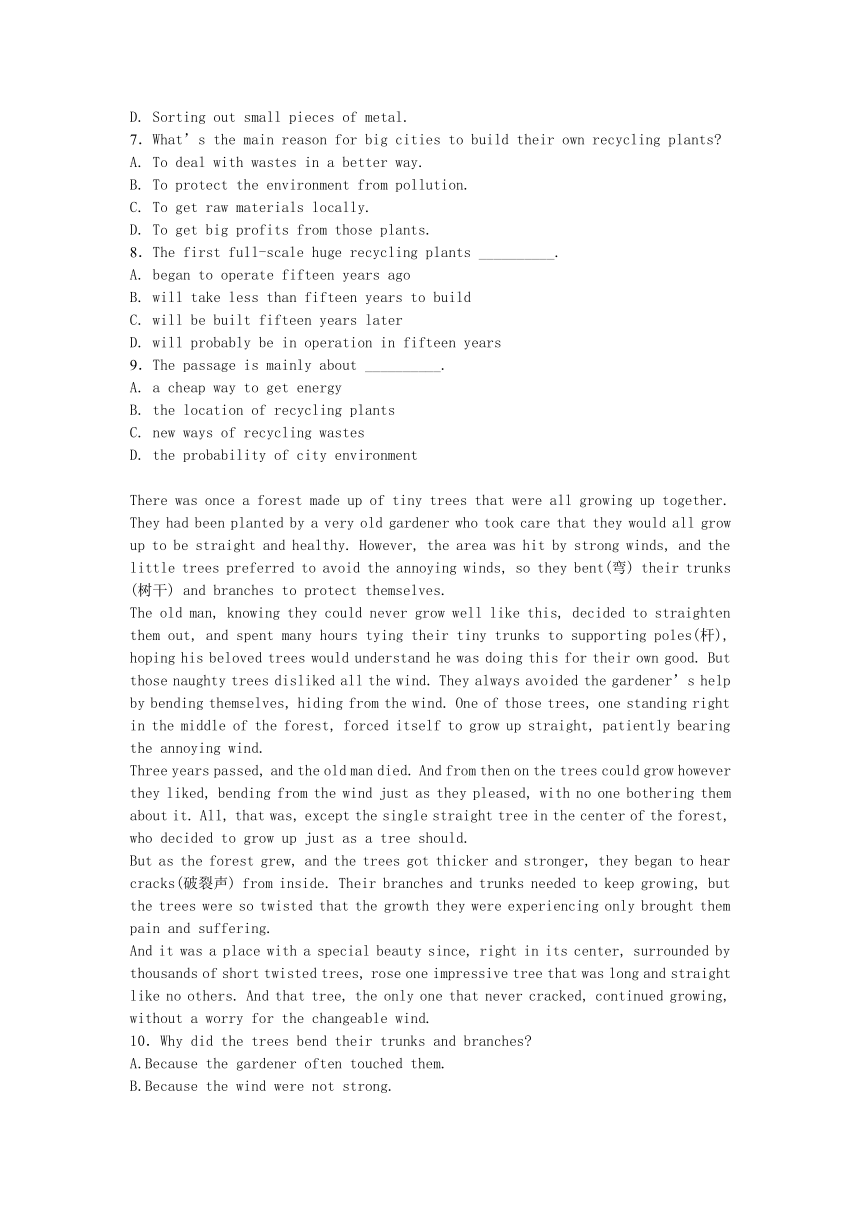【知识点专区】2015年高中英语 阅读理解科普环保类阅读 专项练习(含解析)
文档属性
| 名称 | 【知识点专区】2015年高中英语 阅读理解科普环保类阅读 专项练习(含解析) |

|
|
| 格式 | zip | ||
| 文件大小 | 41.0KB | ||
| 资源类型 | 教案 | ||
| 版本资源 | |||
| 科目 | 英语 | ||
| 更新时间 | 2014-11-08 11:24:47 | ||
图片预览



文档简介
评卷人
得分
一、阅读理解
Cheaters called “pirates” often use camcorders(便携式摄像机) and cell phones to make illegal copies of blockbusters(大片) in the local theater. These pirates then sell those recordings on the street or over the Internet for very low prices. Some share them for free.
“It’s unfair for people to pirate movies, ” says 15-year-old Hadaia Azad Ezzulddin. Movie piracy “takes money out of the pockets of thousands of people in the movie industry,” she notes. Victims include famous actors and directors as well as local theater owners and their employees.
Hadaia came up with an idea that could help stop movie piracy. Hadaia’s idea uses infrared(红外线的) light. This range of light is invisible to the human eye. It is visible, however, to many types of cameras. Theater owners could place small infrared lights on their movie screens. The lights would not disturb people watching the movie. It would, however, distort the recordings made by many types of cameras.
To test her idea, Hadaia built a box with a movie screen inside. Then, she projected images on that screen through a hole in the box. She took recordings of those images, using nine different types of cameras. These included the types found in cell phones as well as camcorders. During some tests, she also turned on light emitting diodes(发光二极管), or LEDs. The LEDs were embedded(植入的) in a certain place behind the movie screen. They gave out infrared light.
Sure enough, she showed, a pirated movie included odd stripes or spots if it had been recorded while the LEDs were on. It might be possible to use the LEDs to flash the date and time on the movie screen. The information would then appear in the illegal recordings. Theater owners or police might use the information to track down the pirates.
Cutting down on piracy might get more people into theaters to watch the real movie instead of an illegal copy. Six out of every ten films now produced aren’t profitable. They don’t make enough money to recover how much was spent to make and market them. Such a poor payback can discourage filmmakers from producing anything but the types expected to become blockbuster hits. It might also keep smaller theaters from showing a wider variety of movie types.
1. From what Hadaia says in Paragraph 2, we can infer that _______.
A. most people spend less money on pirates moves
B. the pirates don’t have to pay for the movie tickets
C. theater owners will increase the price of movie tickets
D. she strongly criticizes those who video movies in the theater
2. Infrared lights are put on the movie screens to _______.
A. adjust the brightness of the movie screens
B. make sure the images of movies are dark
C. protect the eyesight of viewers in the darkness
D. make illegal copies of movies unpleasant to see
3.What is the correct order of the steps in Hadaia’s test?
a. She projected pictures on the screen.
b. She used cameras to record the pictures.
c. She turned on the LEDs placed behind the screen.
d. She made a special box with a movie screen inside.
A. bacd B. dcab C. dbac D. bcad
4.According to the last paragraph, we can know that _______.
A. forty percent of movies now are profitable
B. small theaters often choose to show low-cost movies
C. more and more people go to theaters to fight movie piracy
D. filmmakers prefer to produce ordinary movies than blockbusters
With fifteen years Britain and other nations should be well on with the building of huge industrial complexes for the recycling of waste. The word “rubbish” could lose its meaning because everything which goes into the dumps would be made into something useful. Even the most dangerous and unpleasant wastes would provide energy if nothing else.
The latest project is to take a city of around half a million inhabitants and discover exactly what raw materials go into it and what go out. The aim is to find out how much of these raw materials could be provided if a plant(发电厂) for recycling waste were built just outside the city. This plant would recycle not only metal such as steel, lead and copper, but also paper and rubber as well.
Another new project is being set up to discover the best ways of sorting and separating the rubbish. When this project is complete, the rubbish will be processed like this: First, it will pass through sharp metal bars which will tear open the plastic bags in which rubbish is usually packed; then it will pass through a powerful fan to separate the lightest elements from the heavy solids; after that founders and rollers will break up everything that can be broken. Finally , the rubbish will pass under magnets(磁铁), which will remove the bits of iron and steel; the rubber and plastic will then be sorted out in the final stage.
The first full-scale giant recycling plants are perhaps fifteen years away. Indeed, with the growing cost of transporting rubbish to more distant dumps, some big cities will be forced to build their own recycling plants before long.
5. The phrase “be well on with ……” (Para .1) most probably means __________.
A. have completed what was started
B. get ready to start
C. have achieved a great deal in
D. put an end to
6.What is NOT mentioned as a part of the recycling process described in paragraph 3?
A. Breaking up whatever is breakable.
B. Sharpening metal bars.
C. Separating light elements from the heavy ones.
D. Sorting out small pieces of metal.
7.What’s the main reason for big cities to build their own recycling plants?
A. To deal with wastes in a better way.
B. To protect the environment from pollution.
C. To get raw materials locally.
D. To get big profits from those plants.
8.The first full-scale huge recycling plants __________.
A. began to operate fifteen years ago
B. will take less than fifteen years to build
C. will be built fifteen years later
D. will probably be in operation in fifteen years
9.The passage is mainly about __________.
A. a cheap way to get energy
B. the location of recycling plants
C. new ways of recycling wastes
D. the probability of city environment
There was once a forest made up of tiny trees that were all growing up together. They had been planted by a very old gardener who took care that they would all grow up to be straight and healthy. However, the area was hit by strong winds, and the little trees preferred to avoid the annoying winds, so they bent(弯) their trunks (树干) and branches to protect themselves.
The old man, knowing they could never grow well like this, decided to straighten them out, and spent many hours tying their tiny trunks to supporting poles(杆), hoping his beloved trees would understand he was doing this for their own good. But those naughty trees disliked all the wind. They always avoided the gardener’s help by bending themselves, hiding from the wind. One of those trees, one standing right in the middle of the forest, forced itself to grow up straight, patiently bearing the annoying wind.
Three years passed, and the old man died. And from then on the trees could grow however they liked, bending from the wind just as they pleased, with no one bothering them about it. All, that was, except the single straight tree in the center of the forest, who decided to grow up just as a tree should.
But as the forest grew, and the trees got thicker and stronger, they began to hear cracks(破裂声) from inside. Their branches and trunks needed to keep growing, but the trees were so twisted that the growth they were experiencing only brought them pain and suffering.
And it was a place with a special beauty since, right in its center, surrounded by thousands of short twisted trees, rose one impressive tree that was long and straight like no others. And that tree, the only one that never cracked, continued growing, without a worry for the changeable wind.
10.Why did the trees bend their trunks and branches?
A.Because the gardener often touched them.
B.Because the wind were not strong.
C.Because they protected themselves from being destroyed.
D.Because they were very shy and afraid to meet the wind.
11.What can we infer from Paragraph 2?
A.The gardener was kind and treated the trees well.
B.The trees disliked the gardener.
C.The gardener was cruel to the trees.
D.The trees were all naughty.
12.How long did the old gardener look after the trees?
A. Two years. B. Three years.
C. Four years. D. Five years.
13. We can learn from the fourth paragraph that .
A. the trees lived happily
B. the trees liked to stay with each other
C. the trees missed the old gardener
D. the trees suffered from their actions
On March 25, 2013, two pandas were shipped from China to Canada. The pandas received a warm welcome to the North America from Canada’s Prime Minister Step
hen Harper and Chinese ambassador(大使)Zhang Junsai.
The pandas will spend five years at the Toronto Zoo, and then spend another five years at the Calgary Zoo. This is the first time in 20 years that pandas have been sent to a Canadian zoo. “I want to offer my sincere thanks to the government of China for sharing these two pandas, symbolizing peace and friendship, with all Canadians, ”said Prime Minister Harper.
The pandas are named Er Shun and Da Mao. Er Shun, a five-year-old female, came from the Chongqing Zoo, in southwest China. Da Mao, a four-year-old male, traveled from Chengdu. The panda passengers were given plenty of snacks throughout the flight. Each panda received more than 200 pounds of bamboo and 100 pounds of apples.
The number of pandas is decreasing and now there are only 1, 600 pandas left in the wild. And this is partly due to the loss of their primary food source, bamboo. According to a recent study, warming temperatures are causing a shortage of bamboo in at least one region of China where pandas live.
The climate in Er Shun and Da Mao’s new home in Canada isn’t perfect for growing bamboo. Twice a week, the Memphis Zoo, in Tennessee, will ship about 700 pounds of the green plant up north to the Toronto Zoo. While the pandas are far from China, zookeepers plan to make Canada feel like their home.
14.We can know from the second paragraph that .
A. China often sends pandas to Canada
B. Canada is very thankful for China’s help
C. the two pandas will spend ten years in Canada
D. the two pandas will only live in one place.
15.According to the passage, the two pandas .
A. are both four years old
B. are from the same Chinese zoo
C. can eat as many as 100 pounds of apples in a day
D. were given over 400 pounds of bamboo on the flight
16.What is Paragraph 4 mainly about?
A. The reason for the decreasing number of pandas.
B. The primary food source of pandas.
C. The lifestyle of pandas in the wild.
D. The effects of warming temperatures on bamboo.
17.It can be learned from the passage that .
A. pandas eat nothing but bamboo and apples
B. the climate in Toronto is unfit for bamboo to grow
C. the animal that all Canadians like best is pandas
D. China lent the two pandas just in order to help Canada
参考答案
1.D
2.D
3.B
4.A
【解析】
试题分析:本文讲述盗版电影严重损害人们的利益,Hadaia想到一个方法来帮助减少盗版。
1.D 细节推断题。根据第二段提到“It’s unfair for people to pirate movies,盗版电影对于人们来说是不公平的,故选D项。
2.D 细节推断题。根据第三段提到Theater owners could place small infrared lights on their movie screens. The lights would not disturb people watching the movie. It would, however, distort the recordings made by many types of cameras.电影院会向屏幕上投射红外线,观众不会受到影响,但受使许多录像机受到影响,故为了杜绝盗版,故选D项。
3.B 细节推断题。根据第四段提到To test her idea, Hadaia built a box with a movie screen inside.为了检验一下他的想法,这是第一步,再根据During some tests, she also turned on light emitting diodes(发光二极管), or LEDs.可知这是第二步,再放映电影,再录下来,可知选B项。
4.A 细节推断题。根据最后一段Cutting down on piracy might get more people into theaters to watch the real movie instead of an illegal copy. Six out of every ten films now produced aren’t profitable.为了打击盗版,百分六十电影不是投影的,故选A项。
考点:社会现象类阅读。
5.C
6.B
7.A
8.D
9.C
【解析】
试题分析: 垃圾一直是城市环境的一大难题。现在,英国等许多国家正在计划建造大型的垃圾处理厂,把没用的垃圾为清洁的能源。
5.词义推测题。文章第一段介绍,在15年之内,英国和其他国家应该会顺利地建起大型工业中心以处理回收的废弃物。 “垃圾”有可能不再是垃圾,因为垃圾会变成有用的东西。如果没有别的提供能量,即使是最危险的和令人不愉快的废物都会用来提供能源。所以选C。(在某一方面取得很大的成就。)
6.细节理解题。第三段介绍,垃圾处理的方法:垃圾分类和分别处理。第一,用尖的金属棒,撕开装垃圾的塑料袋;然后将用强力风扇分开最轻的和沉重的固体;之后把能打碎的都打碎。最后,用磁铁除去钢铁碎片;最后把橡胶和塑料整理出来。各选项的意思是A. Breaking up whatever is breakable.打碎可以打碎的任何东西;B. Sharpening metal bars.磨尖金属棒;C. Separating light elements from the heavy ones.轻、重元素分开;D. Sorting out small pieces of metal.小的金属块被分类。故B没有提及,所以选B。
7.细节理解题。根据文章最后一句话可知,事实上,运送垃圾到更遥远的垃圾场使成本日益增长,将迫使一些大城市建立自己的回收工厂。选A。
8.细节理解题。根据文章最后一段The first full-scale giant recycling plants are perhaps fifteen years away. 第一个完整的大型回收厂也许还有十五年才能建成。所以选D。
9.主旨大意题。全文的意思是,垃圾将来会通过工厂加工成为能源。这是处理垃圾的心方法。所以选C。
考点: 社科类阅读。
10.C
11.A
12.B
13.D
【解析】
试题分析: 本文讲述小树为了避免大风弯下腰,即使有园丁帮助扶起来,也不愿意直起腰身,等园丁死后,他们按照自己的意愿长大,随着枝干的生长,树开始承受痛苦,慢慢的断裂,只有一棵直立的树傲然迎风,告诉我们只有直立才能接受挑战。
10.C 细节理解题。根据第一段提到the little trees preferred to avoid the annoying winds, so they bent(弯) their trunks (树干) and branches to protect themselves.他们弯腰为了保护他们自己,故选C项。
11.A 推断题。根据第二段提到The old man, knowing they could never grow well like this, decided to straighten them out, and spent many hours tying their tiny trunks to supporting poles(杆), hoping his beloved trees would understand he was doing this for their own good.老人知道他们不能象这样,决定把他们弄直来帮他他们,故选A项。
12.B 细节理解题。根据第三段提到Three years passed, and the old man died.可知照顾了三年,故选B项。
13.D 细节推断题。根据第四段提到Their branches and trunks needed to keep growing, but the trees were so twisted that the growth they were experiencing only brought them pain and suffering.树枝要生长,便树太弯曲了,成长带给他们的只有苦痛,故选D项。
考点:故事类阅读。
14.C
15.D
16.A
17.B
【解析】文章大意:本文讲述了2013年3月25日, 两只大熊猫从中国被运到了加拿大, 并对他们在加拿大将要度过的十年以及两国的动物园将要做什么样的工作来使他们适应在加拿大的新家做了描述。
14.细节理解题。根据第二段第一句The pandas will spend five years at the Toronto Zoo, and then spend another five years at the Calgary Zoo. 可知它们将会在加拿大一共待10年。
15.细节理解题。根据第三段最后一句可知, 在运送过程中每只熊猫被给食200多磅竹子, 两只熊猫就是400多磅。
16.段落大意题。根据第四段The number of pandas is decreasing and now there are only 1, 600 pandas left in the wild. And this is partly due to. . . 可知本段主要讲述了野外大熊猫数量在减少及其原因。故选A。
17.细节理解题。根据最后一段第一句可知多伦多的气候不适宜竹子生长, 故选B。
